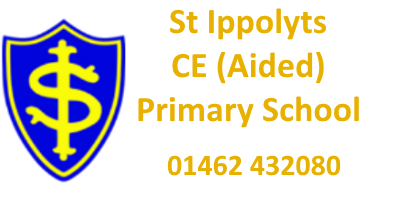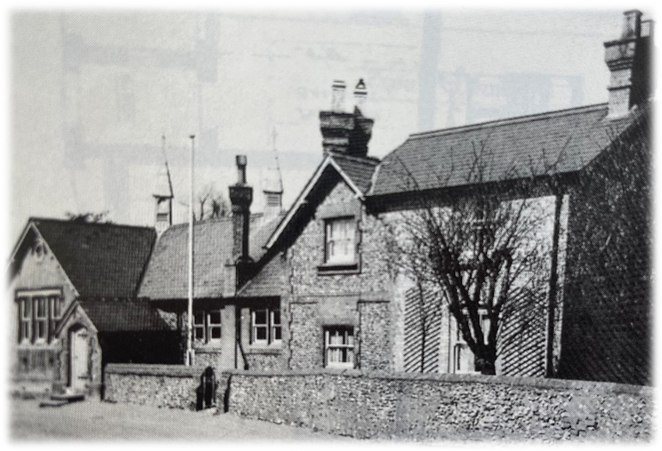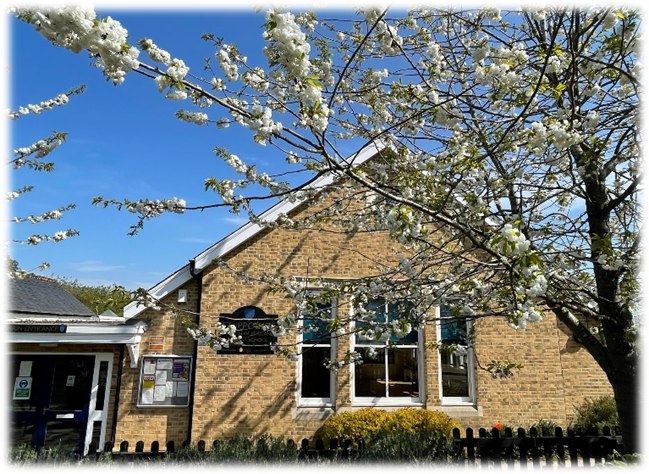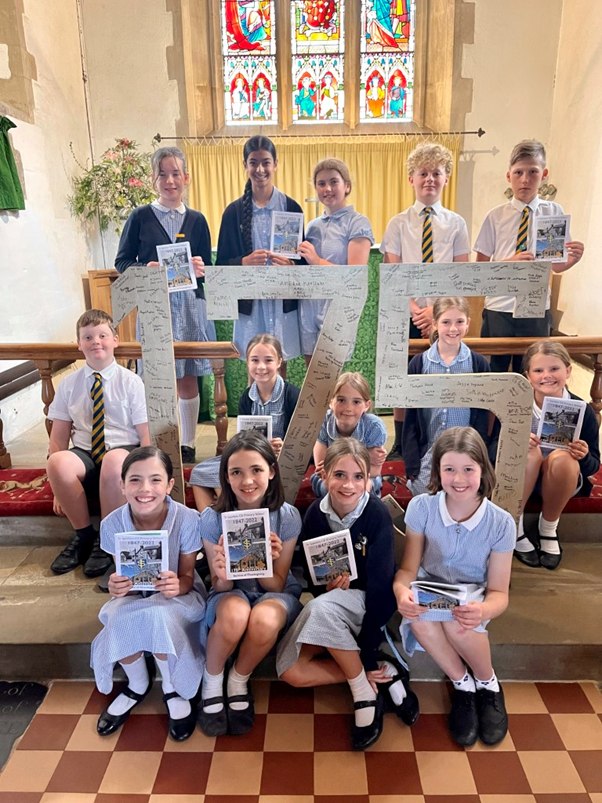St Ippolyts Primary School was founded in 1847 to serve the children of the parish; a principle which continues to be the cornerstone of our work in modern day.
In 2022 we celebrated our 175th Anniversary with a Service of Thanksgiving in St Ippolyts Church, led by the children. During that service, the children took us on a journey of our school through time, which you can read below.
Part 1: The beginning
St Ippolyts School, referred to in the beginning as ‘St Ippolyts National School’ was constructed in 1846 by Joseph Bates. It initially was an open school room parallel to the road with a smaller room attached to the schoolhouse. The school has always been a ‘church school’. Thomas Henry Steel was Vicar when the school was opened in 1847, and on Monday 8th March, 43 children arrived to meet their new teacher, Miss Jefford. Her monthly salary was £2.1s.8d, plus half the children’s fees of tuppence a week. An older child, Eliza Pedder was paid 6d a week to help keep order, and Miss Ross came in several times a week to teach plaiting.
In order to furnish the building with desks and chairs, money needed to be raised. On the 28th November 1870 ratepayers met to discuss the best way to fulfil the education requirements. The plan was to convert the existing school room into an infant’s school and build a large new room for older pupils. This was then remodelled and built in 1871.There were now 90 children on the register.
Victorian lessons were mainly concerned with the ‘3R’s’ – reading, writing and arithmetic. Teachers often made the children learn the reading book by heart, so they would pass the yearly test. Young children learnt to write by copying letters form the blackboard onto a slate. Older children used a pen with a nib, which had to be dipped into the ink using a copper plate style of writing. Science was taught by showing children objects and the teacher reading about it.
Part 2: The War Years
During the first war years the school children subscribed £2 to the Belgian Refugees Fund, they also subscribed for wool, the girls knitted it into helmets and socks for the Sailor’s and Soldier’s Relief Fund. A new plot of land was also lent to the children for gardening during the war. On the 27th September 1918 the children gathered 77lbs of blackberries for jam making. Children were also given the task of stoning the raisins ready for the teacher to make Christmas puddings.
As St Ippolyts is a church school prayers and hymns were sung every morning. Pupils attended services to celebrate the various religious festivals the highlight was the children were given the remainder of the day off after the service had ended. Children had to do some schooling at the village hall due to giving up time to evacuees. The headteacher was Mr J.J.P. Cole a strict man who was respected by his pupils.
By the time of the Second World War the headmaster at the time was Mr Taylor. When the war started all the children went to St Ibbs to be fitted with gas masks. The expectation was that the children would carry them to school each day in a cardboard box, hung round their necks with string. Children would practice getting into lines to go to the air raid shelter once a week, which was situated where the playground now is. The area at the side of the school was tug up into trenches. School dinners were provided at the British Legion Hut on the London Road, where thick vegetable soup and toast, semolina pudding and jam tart and custard for afters. Toilets were also outside. The big bell in the school used to ring every morning and afternoon to call the children to school.
During the harsh winters children would toboggan down the hill to the foundry and in the summer months children were walked down to the bus stop to get the bus into Hitchin, where they had swimming lessons or went to the rough meadow at the corner of Ashbrook Lane and played rounders, trying to avoid the cows. The school had very little outside activities but on very rare occasions somebody would come to give a puppet show after school hours, for which a small charge was made.
School closed for 2 days on the 8th and 9th of May 1945, a National Holiday to celebrate V.E. Day on the conclusion of the war. A large tea party took place in the village hall followed by organised sports in the park.
The Extension in the 1950’s
October 1951 saw the beginning of meetings to discuss with the Vicar the possibility of additional buildings to the school. The school architect Mr Muncey and Mr New attended a meeting three years later to discuss the plans for the new classroom and kitchen.
In 1953 Queen Elizabeth II was crowned a day’s holiday was granted. Building work had begun on the north boys’ playground for new classrooms and indoor toilets and the girls’ south playground for a new kitchen. The school didn’t have central heating but was warmed by open fires, where the free milk was lined up to give a warm drink at mid-morning break.
A year later, on the 27th September 1955 there was a School Dedication Service of the extension (where Class 5 and 6 are now) by the Lord Bishop of St Albans which was then followed by lunch provided by the new canteen and attended by the children and 35 invited guests.
After a beautiful service there was a procession to school. When the Bishop reached the door of the School, the Vicar said the following:
Reverend Father in GOD, we ask you to dedicate these classrooms and other extensions of our school
The Bishop: We, Michael, by divine permission Bishop of St Albans, do hereby dedicate these buildings to the perpetual service of Almighty GOD, for the education of children: in the name of the Father and of the Son and of the Holy Ghost. Amen.
In 1957 the Headmaster Mr Sargeant, was also the church warden and so he did a great deal to foster the links between school and church.
The new hall
As the new millennium dawned, with Mrs Nelson as Headteacher, plans were afoot to build a much-needed extension to the school. The number of children attending was growing and it was becoming difficult to provide a modern curriculum in a cramped building.
In the early 2000s work began on building a new hall, classrooms and offices, which would dramatically increase the size of the school. It was a complex project because the new build had to be in-keeping with the style of the original Victorian building. Funding had been secured from the Diocese, but the Governing Body had to pay 10% of the costs. A fundraising committee called the SHARP Appeal was set up (this stood for School Hall And Refurbishment Project). Over a number of years and countless events to raise funds, over £120,000 was raised to enable to build to go ahead.
The building was completed in the late autumn of 2004 and was officially opened with a service of blessing in St Ippolyts Church on Tuesday 8th March 2005. The new building was blessed by the Bishop of St Albans and there was a celebratory tea in the hall afterwards. The new hall marked the start of a new era for St Ippolyts School. Mrs Peddie became Headteacher in September 2009 and is still in post as we celebrate 175 years.
Growing
St Ippolyts village is a growing and thriving community with the school at its heart. Increasing numbers of children were applying for places and by 2017, the school expanded from 5 classes to 6. This enabled the school to take more children.
Our creative, vibrant curriculum has been a strength of the school for a sustained period of time. We know that all children have differing strengths, interests and passions and we endeavour to provide wide ranging opportunities for them to shine. Learning is enriched through things like arts days, science days, trips, wellbeing week, and a wide range of fantastic sports.
We help children ‘learn how to learn’ using Learning Powers. Pupils are given the opportunity to guide their own learning with confidence and independence, using the four Learning Powers: Reflectiveness, Resourcefulness, Resilience and Relationships. Support for children’s mental, physical and emotional health is woven throughout the curriculum and the school’s Christian values are at the heart of everything we do.
Spring 2020 saw the arrival of the coronavirus pandemic. School was closed to most pupils from March – September 2020 and then again from January – March 2021. Children had to do their lessons remotely and teachers had to learn how to teach over video link. There were live PE lessons, music lessons and Wellbeing Wednesday videos to name a few. It was a very strange time for everyone, but the school community remained united under a tagline of ‘Stronger Together’.
As for the future… as children we will grow up, move on and leave our primary school days behind us. But we will take with us precious memories and values for life, just like the generations of children who have gone before us and those who are yet to come. One thing is for certain – we will always be part of the St Ipps Family.
As told by the children of the Young Worship group, Summer 2022






